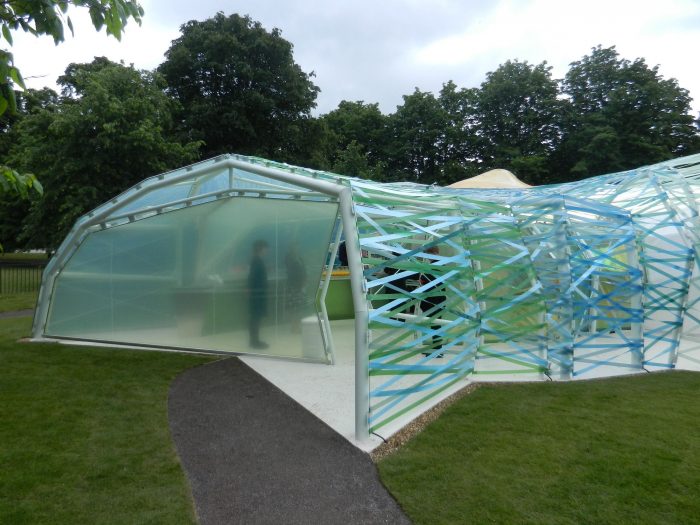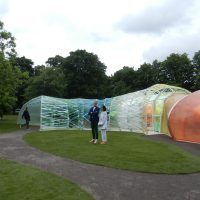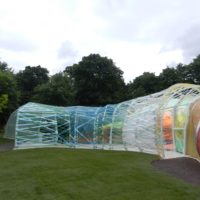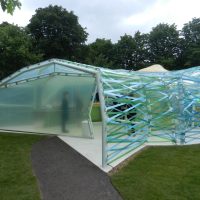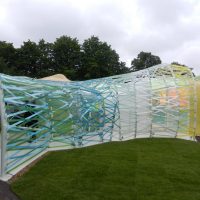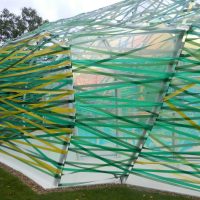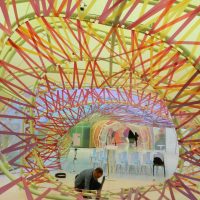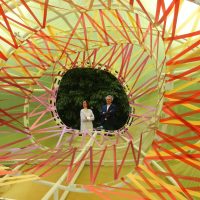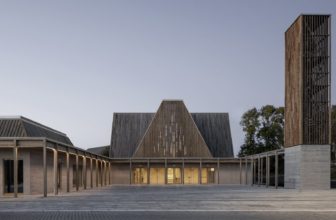Serpentine Pavilion 2015
As of June 25th, London’s royal Kensington Gardens are host, in a 15th edition, to the world-renowned annual Serpentine Pavilion. This year, directors of the Serpentine Gallery Julia Peyton-Jones and Hans Ulrich Obrist, commissioned Spanish couple José Selgas and Lucía Cano, better known as selgascano, to design the Serpentine Pavilion 2015. With this project, the award-winning studio completed their first new structure in the UK. They also are the first Spanish architects to receive this invitation, following a line of A-list guests, such as Zaha Hadid, Herzog & de Meuron, Oscar Niemeyer, Jean Nouvel, or Peter Zumthor. The amorphous pavilion stands as a colorful object, contrasting and simultaneously blending in with its natural surrounding. Two double-skinned ‘tubes’ of translucent ETFE plastic meet in the middle to form a central open space for gatherings and a café. Visitors are free to move as they please, making their own path around the structure. According to ‘selgascano’, this is what the architectural concept is based on: an ambiguous, unfinished object, which connects people in a similar fashion to London’s Underground – a symbol of the city’s urban life.
The amorphous pavilion stands as a colorful object, contrasting and simultaneously blending in with its natural surrounding. Two double-skinned ‘tubes’ of translucent ETFE plastic meet in the middle to form a central open space for gatherings and a café. Visitors are free to move as they please, making their own path around the structure. According to ‘selgascano’, this is what the architectural concept is based on: an ambiguous, unfinished object, which connects people in a similar fashion to London’s Underground – a symbol of the city’s urban life.
 The use of colored ETFE plastic for the pavilion is part of the studio’s ongoing interest in research and experimenting new materials in architecture. “We sought a way to allow the public to experience architecture through simple elements: structure, light, transparency, shadows, lightness, form, sensitivity, change, surprise, colour and material”, the practice mentions. The metal structure holds the plastic like a tent. Its morphology rises from the architects’ desire to stretch out the material as much as possible in order to get the best results.
The use of colored ETFE plastic for the pavilion is part of the studio’s ongoing interest in research and experimenting new materials in architecture. “We sought a way to allow the public to experience architecture through simple elements: structure, light, transparency, shadows, lightness, form, sensitivity, change, surprise, colour and material”, the practice mentions. The metal structure holds the plastic like a tent. Its morphology rises from the architects’ desire to stretch out the material as much as possible in order to get the best results. In the 15th anniversary of the Pavilion, the architects this year also thought of creating a tribute to previous pavilions and “a homage to all the stories told within those designs”, as they put it. Reactions came as soon as the pavilion was unveiled – both positive and negative. To think about it, the mixed comments are not surprising, as selgascano’s unconventional design follows projects by Pritzker-winning star architects. While some question the use of plastic for this location, others dislike the finished details of the construction. However, one should keep in mind that the pavilion is a temporary structure – one which will be dismantled on October 18th and sold as an art piece, or “auteur architecture”. As noted in this article by Domus, the future of the pavilion remains uncertain after this date – previous ones were reused for cultural events, others were bought for commercial purposes and some have never been reassembled. With this in mind, selgascano’s approach might not seem so unconventional, after all.
In the 15th anniversary of the Pavilion, the architects this year also thought of creating a tribute to previous pavilions and “a homage to all the stories told within those designs”, as they put it. Reactions came as soon as the pavilion was unveiled – both positive and negative. To think about it, the mixed comments are not surprising, as selgascano’s unconventional design follows projects by Pritzker-winning star architects. While some question the use of plastic for this location, others dislike the finished details of the construction. However, one should keep in mind that the pavilion is a temporary structure – one which will be dismantled on October 18th and sold as an art piece, or “auteur architecture”. As noted in this article by Domus, the future of the pavilion remains uncertain after this date – previous ones were reused for cultural events, others were bought for commercial purposes and some have never been reassembled. With this in mind, selgascano’s approach might not seem so unconventional, after all. Regardless of the side taken in this debate, undoubtedly this year’s Serpentine Pavilion followed a different approach. With their design, the Spanish architects promote experiment, proving that architecture can be fun and may occasionally not take itself too seriously – especially when it comes to temporary structures. The Serpentine Pavilion 2015 is open throughout summer, so if you happen to be in London, make sure to visit it and develop your own impression about it!
Regardless of the side taken in this debate, undoubtedly this year’s Serpentine Pavilion followed a different approach. With their design, the Spanish architects promote experiment, proving that architecture can be fun and may occasionally not take itself too seriously – especially when it comes to temporary structures. The Serpentine Pavilion 2015 is open throughout summer, so if you happen to be in London, make sure to visit it and develop your own impression about it!
By: Ana Cosma
- photography by © Daniel Portilla
- photography by © Daniel Portilla
- photography by © Daniel Portilla
- photography by © Daniel Portilla
- photography by © Daniel Portilla
- photography by © Daniel Portilla
- photography by © Daniel Portilla


